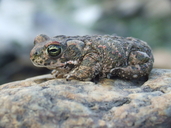|
Description
A typical toad appearance. Parotoids behind the eyes are prominent. Pupil of the eye is horizontal. Tympanic membrane and male guttural resonator. Subarticular tubercles on the inner surface of toes paired. Internal edge of the tarsus with longitudinal skin fold. Tip of the 4th finger does not reach the 1st articulation of 3rd finger. Dorsal skin tuberculate, grayish-olive in color with more or less dark spots and light narrow middorsal line. Belly light-colored.
Sexual dimorphism similar to that in the Green Toad (Bufo viridis).
Distribution and Habitat
Country distribution from AmphibiaWeb's database: Austria, Belarus, Belgium, Czech Republic, Denmark, Estonia, France, Germany, Ireland, Latvia, Lithuania, Luxembourg, Netherlands, Poland, Portugal, Russian Federation, Spain, Sweden, Switzerland, Ukraine, United Kingdom
This toad is native to southwestern and central Europe: Portugal, Spain, France, Southwestern Ireland, Great Britain, Belgium, The Netherlands, Luxembourg, Germany, Switzerland, Austria near the Czech border, Czech Republic, Poland, Western Ukraine, Byelorussia, Lithuania, Latvia, Estonia (northwards to Tallin City), Western Russia (Kaliningrad Province), Denmark and Sweden.
The Natterjack toad inhabits mainly open, well-warmed landscapes with light, sandy soils. There, it lives in sand dunes, glades of pine forests, gardens, parks, fields, sand and gravel quarries and meadows. In the daytime, it hides in heaps of stones, in sandy soil and under debris. Reproduction takes place in shallow, well-warmed ponds, puddles and ditches, including those with admixture of salt water on the shore of the Baltic Sea. Life History, Abundance, Activity, and Special Behaviors
Populations are not usually very large. However, in some places the density has reached 200 individuals per hectare. The populations sometimes reach high densities in agricultural landscapes. For example, in the fields of central Byelorussia 7 specimens per 10 m2 have been censused.
Hibernation occurs from September - October to March - May in the same sites where it hides in summer. Otherwise, the toad buries itself in the soil. Reproduction occurs in different months, in dependence on the latitude. Breeding choruses reach maximum intensity in the evening. The mating call differs from that in the Green Toad (B. viridis). Amplexus is pectoral. The clutch contains 2800-4000 eggs deposited in two strings of 1-2 m length. Metamorphosis occurs usually in summer, but cases of larval overwintering are known. The mass appearance of newly metamorphosed toadlets is typical. Adult age may attain 17 years. The diet consists mainly of crawling invertebrates (ants, beetles etc.); mirmecophagy is typical, like in other congeneric species.
Trends and Threats
Many populations of this species are decline because of anthropogenic pressure, primarily alteration of its specialized habitats: afforestation of heath lands and their reclamation for agriculture, acidification of breeding ponds due to polluted rains, use of coastal dunes for holiday industry (Beja et al 2009).
There have been translocation projects for the Natterjack toad in the UK, which have had signs of success, probably due to coupling the reintroduction effort with large scale habitat restoration and maintenance effort (Seigel and Dodd 2001).
The Natterjack toad is considered endangered in Ireland, where projects such as pond restoration in protected areas are coordinated with release of toadlets from ex situ breeding programs (Beja et al 2009).
Relation to Humans
Negative effects of habitat alteration by humans on the toad populations were indicated above. However, in some places (e.g., in Byelorussia) its number increases in some agricultural lands where the toads can be seen breeding in catchment ponds. The toad does not avoid anthropogenic landscapes, but usually its abundance there is not high.
Comments
References
Bannikov, A. G., Darevsky, I. S. and Rustamov, A. K. (1971). Zemnovodnye i Presmykayushchienya SSSR [Amphibians and Reptiles of the USSR]. Izdatelistvo Misl, Moscow.
Bannikov, A. G., Darevsky, I. S., Ishchenko, V. G., Rustamov, A. K., and Szczerbak, N. N. (1977). Opredelitel Zemnovodnykh i Presmykayushchikhsya Fauny SSSR [Guide to Amphibians and Reptiles of the USSR Fauna]. Prosveshchenie, Moscow.
Beebee, T. J. C. (1983). The Natterjack Toad. Oxford University Press, Oxford.
Beja, P., Kuzmin, S., Beebee, T., Denoel, M., Schmidt, B., Tarkhnishvili, D., Ananjeva, N.B., Orlov, N.L., Nyström, P., Ogrodowczyk, A., Ogielska, M., Bosch, J., Miaud, C., Tejedo, M., Lizana, M. & Martinez Solano, I. 2009. Epidalea calamita (errata version published in 2016). The IUCN Red List of Threatened Species 2009: e.T54598A86640094. https://dx.doi.org/10.2305/IUCN.UK.2009.RLTS.T54598A11160828.en.
Gasc, J. P. , Cabela, A., Crnobrnja-Isailovic, J., Dolmen, D., Grossenbacher,K., Haffner, P., Lescure, J., Martens, H., Martinez Rica, J. P.,Maurin, H., Oliveira, M. E., Sofianidou, T. S., Vaith, M., and Zuiderwijk, A. (1997). Atlas of Amphibians and Reptiles in Europe. Societas Europaea Herpetologica and Muséum National d’Histoire Naturelle, Paris.
Grosse, W.-R. (1994). ''Biologie und Okologie der Kreuzkrote.'' Berichte des Landesamtes amt für Umweltschutz Sachsen-Anhalt, 14, 1-95.
Gruodis, S., Zaune, I. and Vilnitis, V. (1986). ''Present situation of the investigation of Running Toad (Bufo calamita Laurenti) in the Eastern Baltics.'' Okhrana. Ekologiya i Etologiya Zhivotnykh, Riga, 73-96.
Korky, J. K., and Webb, R. G. (1999). ''Resurvey, biogeography and conservation of the Natterjack Toad Bufo calamita Laurenti (Anura: Bufonidae) in the Republic of Ireland.'' Bulletin of the Irish Biogeographical Society, (23), 2-52.
Kuzmin, S. L. (1995). Die Amphibien Russlands und angrenzender Gebiete. Westarp Wissenschaften, Magdeburg.
Kuzmin, S. L. (1999). The Amphibians of the Former Soviet Union. Pensoft, Sofia-Moscow.
Nöllert, A. and Nöllert, C. (1992). Die Amphibien Europas. Franckh-Kosmos Verlags-GmbH and Company, Stuttgart.
Seigel, R. A. and Dodd, C.K., Jr. (2001). ''Translocations of amphibians: proven management method or experimental technique?'' Conservation Biology, 16(2), 552-554.
Originally submitted by: Sergius L. Kuzmin (first posted 1999-09-30)
Edited by: Vance T. Vredenburg, Joyce Gross, Peera Chanta, Michelle S. Koo (2021-10-10)Species Account Citation: AmphibiaWeb 2021 Epidalea calamita: Natterjack Toad <https://amphibiaweb.org/species/130> University of California, Berkeley, CA, USA. Accessed Jun 15, 2025.
Feedback or comments about this page.
Citation: AmphibiaWeb. 2025. <https://amphibiaweb.org> University of California, Berkeley, CA, USA. Accessed 15 Jun 2025.
AmphibiaWeb's policy on data use.
|
